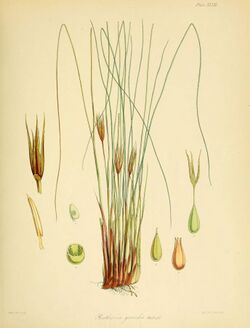Biology:Marsippospermum gracile
| Marsippospermum gracile | |
|---|---|

| |
| Plate XLVII (artist Fitch)[1] | |
| Scientific classification | |
| Kingdom: | Plantae |
| Clade: | Tracheophytes |
| Clade: | Angiosperms |
| Clade: | Monocots |
| Clade: | Commelinids |
| Order: | Poales |
| Family: | Juncaceae |
| Genus: | Marsippospermum |
| Species: | M. gracile
|
| Binomial name | |
| Marsippospermum gracile | |
| Synonyms[2] | |
|
Juncus gracilis (Hook.f.) Walp. | |
Marsippospermum gracile, common name alpine rush,[4] is a flowering plant species in the rush family Juncaceae which is native to New Zealand.[2]
Description
It is a densely tufted, rhizomatomous plant, whose rhizomes are about 5 mm in diameter and horizontal in plants on the South Island ascending in plants from Auckland and Campbell Is. The stems are 8-40 cm by 0.5 mm., and crowded on the rhizome with reddish brown bracts at their base, the upper conspicuously mucronate. The leaves can be roughly equal in length or much greater in length than the flowering stems. They are slightly less than 1 mm. wide, are terete, rigid, striated, bright green, and shining. The flowers are 1.5–3 cm. long, with an inconspicuous bract. There are six unequal tepals, which are pale brown with membraneous margins. There are six stamens. The leathery capsules are about half the length of tepals, and chestnut-brown. The seeds are about 2.5 mm. long, straw-coloured, and shining.[5]
It flowers from December to February and fruits from January to March.[5]
Taxonomy
It was first described in 1844 by Joseph Hooker as Rostkovia gracilis,[2][1] but was assigned to the genus, Marsippospermum in 1879 by the German botanist, Franz Georg Philipp Buchenau, to become Marsippospermum gracile.[2][3] The specific epithet, gracilis/gracile, comes from the Latin, gracilis, meaning "slender, thin, graceful".[6]
Conservation status
In both 2009 and 2012 it was deemed to be "Not Threatened" under the New Zealand Threat Classification System,[4] and this classification was reaffirmed in 2018.[7]
References
- ↑ 1.0 1.1 Hooker, J.D. (1844). "Marsippospermum gracile". The botany of the Antarctic voyage of H.M. discovery ships Erebus and Terror in the Years 1839-1843 :under the command of Captain Sir James Clark Ross 1 (5): 83. https://biodiversitylibrary.org/page/3011421. Plate XLVII
- ↑ 2.0 2.1 2.2 2.3 2.4 "Marsippospermum gracile (Hook.f.) Buchenau | Plants of the World Online | Kew Science". https://powo.science.kew.org/taxon/urn:lsid:ipni.org:names:443976-1.
- ↑ 3.0 3.1 Buchenau, F.G.P. (1879) Abhandlungen herausgegeben vom Naturwissenschaftlichen Vereins zu Bremen. 6: 374
- ↑ 4.0 4.1 "Marsippospermum gracile | New Zealand Plant Conservation Network". http://nzpcn.org.nz/flora_details.aspx?ID=2197.
- ↑ 5.0 5.1 "Flora of New Zealand | Taxon Profile | Marsippospermum gracile". http://www.nzflora.info/factsheet/Taxon/Marsippospermum-gracile.html.
- ↑ "gracilis,-is,-e". http://www.plantillustrations.org/epithet.php?id_epithet=208720%3C/div%3E%3Cdiv%20class=.
- ↑ Lange, Peter J. de; Rolfe, Jeremy R.; Barkla, John W.; Courtney, Shannel P.; Champion, Paul D.; Perrie, Leon R.; Beadel, Sarah M.; Ford, Kerry A. et al. (2018). "Conservation status of New Zealand indigenous vascular plants, 2017". New Zealand Threat Classification Series 22: 70. OCLC 1041649797. https://www.doc.govt.nz/globalassets/documents/science-and-technical/nztcs22entire.pdf.
External links
- Marsippospermum gracile images and occurrence data from GBIF
- Marsippospermum gracile occurrence data from AVH
Wikidata ☰ Q15513110 entry
 |

